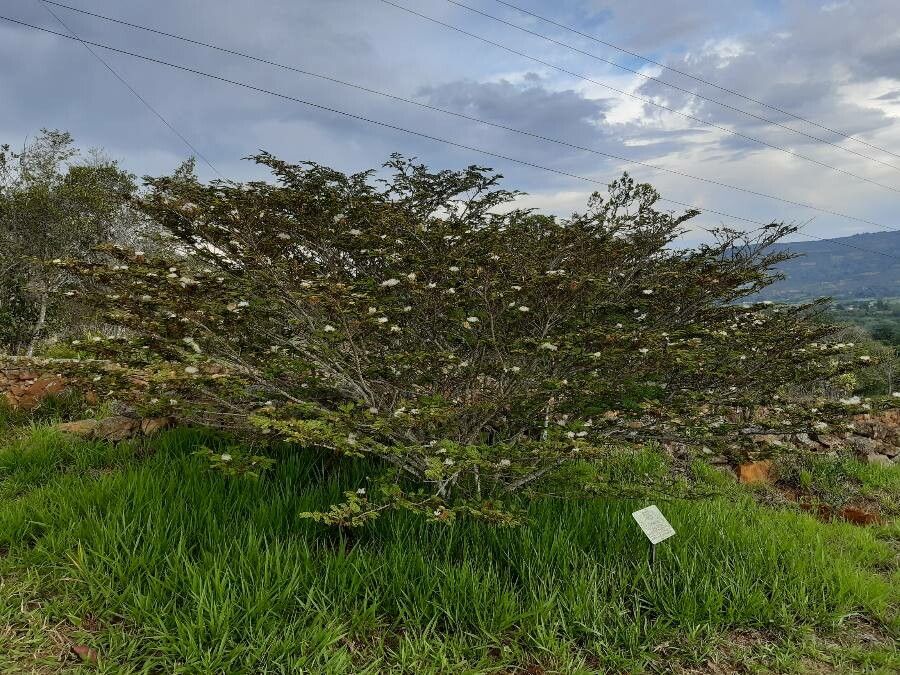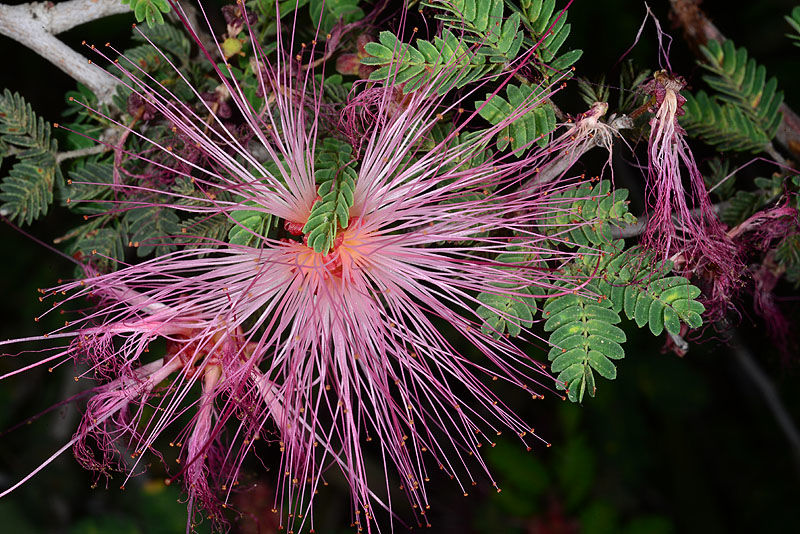Fairy Duster
calliandra eriophylla
Also known as: ["Fairy Duster","Apache Broom"]
Overview
A deciduous shrub native to the southwestern United States and Mexico, known for its delicate, feather-like flowers that resemble tiny red dust bunnies.
Benefits & Perks
["drought tolerant","wildlife attractant (bees, butterflies, birds)","fragrant flowers"]
Botanical Classification
| Phylum: | Magnoliophyta |
| Class: | Magnoliopsida |
| Order: | Fabales |
| Family: | Fabaceae |
| Genus: | Calliandra |
| Botanical Name: | Calliandra eriophylla |
Plant Characteristics
Basic Information
- Category: Shrubs
- Suitable Location: open, sunny areas in gardens or as a border plant
- Suitable For:
- Is Weed: No
- Allergenicity: low
Environmental Needs
- Climate: {"temperatureRange":"–18–38°C"}
- Hardiness: {"zones":"7–11"}
- Misting: rarely required
- Drainage: Fast-draining to prevent root rot.
- Soil Type: Well-draining, sandy loam with some organic matter; mimics natural desert conditions.
Maintenance Level
- Maintenance Level: low
- Toughness Level: high
- Pruning Frequency: Annually in late winter or early spring before new growth starts.
- Pruning Intensity: Moderate; remove up to one-third of old growth to rejuvenate.
Care Details
Ideal Sunlight Coverage:
Full sun (6–8 hours of direct sunlight daily); tolerates partial shade but may become leggy.
Sunlight Tolerance Tips:
Acclimate plants gradually to intense sunlight; protect from harsh afternoon sun in hot climates; ensure good air circulation to prevent sunburn.
Care Requirements
Care Difficulty
moderatemoderate
Sunlight
full sun
Rotate plant for even light exposure; use shade cloth in extreme heat; avoid sudden light changes.
Watering
every 7–14 days, depending on rainfall and soil moisture
Water thoroughly but infrequently to encourage deep roots; allow soil to dry between waterings; avoid overwatering, especially in winter.
Soil
well-drained, sandy or loamy soil
pH: Slightly acidic to neutral (pH 6.0–7.0).
Ensure soil dries between waterings; avoid heavy clay soils; amend with organic matter if needed.
Temperature
Thrives in warm conditions (65–85°F or 18–29°C); tolerates mild frosts but prefers temperatures above 50°F (10°C).
Avoid sudden temperature shifts; protect from frost; ensure good air circulation in hot weather.
Fertilizing
every 3–4 months during active growth
Fertilize sparingly; apply before new growth emerges; flush soil occasionally to prevent salt buildup.
Propagation
Methods
Stem cuttings or seed; stem cuttings are more reliable for home growers.
Step-by-Step Propagation Guide
- Take 4–6 inch cuttings.
- Remove lower leaves.
- Dip in rooting hormone.
- Plant in medium.
- Keep moist and warm.
Best Time: Spring or early summer when the plant is actively growing.
Environment
Warm (70–75°F or 21–24°C), humid, and bright but indirect light.
Medium
Well-draining mix of perlite and peat moss or cactus mix.
Hormone
Recommended to use rooting hormone for faster root development.
Timeline
Roots may develop in 4–8 weeks; establish in new pot within 3–6 months.
Tools Needed
Pruning shears, rooting hormone, small pots, well-draining medium.
Quick Tips
Use healthy, non-flowering stems; maintain consistent moisture; avoid direct sunlight during rooting.
Pruning & Repotting
Pruning Guide
Method
Selective thinning and heading back to maintain form and promote branching.
Pruning Plan
Shape the plant, encourage bushier growth, and remove dead or weak stems.
Tools
Pruning shears, loppers (for larger stems), gloves.
Checklist
Sterilize tools; prune before flowering; remove dead/damaged stems; shape evenly.
Repotting Guide
Best Season
Early spring before active growth begins.
Pot Size
Move to a pot one size larger (1–2 inches wider in diameter).
Method
Remove plant gently; trim roots if needed; use fresh, well-draining soil; ensure proper drainage.
Suggestions
Repot every 2–3 years or when roots fill the pot; beneficial for younger plants to encourage growth.
Checklist
Choose appropriate pot; prepare new soil; water before repotting; place in appropriate light.
Advanced Care Tips
Watering Mastery
Watering Checklist
Check soil moisture before watering; water deeply; ensure proper drainage; adjust frequency by season.
How to Apply Water Properly
Water directly at the root zone until water drains from the bottom; ensure even moisture without waterlogging; water in the morning to reduce evaporation.
Watering Schedule Tips
Water deeply once every 7–10 days during active growth in spring and summer; reduce to every 3–4 weeks in fall and winter. Adjust based on rainfall and soil dryness.
Soil Improvement
Add perlite or coarse sand to improve drainage; incorporate compost for fertility.
Temperature Stress Management
Signs of Temperature Issues
Chlorosis or leaf drop in cold stress; wilting or scorching in excessive heat.
Cold Stress
Growth slows or halts; leaves may turn yellow or drop; roots can suffer damage in prolonged cold.
Solution: Move to a sheltered location; apply a thick layer of mulch; protect roots with frost cloth if temperatures drop below 28°F (-2°C).
Hot Stress
Leaves may wilt, scorch, or drop; growth may slow; soil dries out faster.
Solution: Provide afternoon shade; increase watering frequency; use mulch to retain soil moisture.
Fertilizing Guide
Fertilizing Checklist
Use balanced fertilizer; apply in spring; avoid over-fertilizing; water before and after application.
Fertilizing Method
Use a balanced, slow-release fertilizer in early spring; dilute liquid fertilizer to half-strength if needed; avoid fertilizing in winter.
Common Problems & Solutions
Toxicity Warning
Cats
Slightly ToxicCats may experience mild gastrointestinal irritation if they consume the seeds or pods of Calliandra eriophylla. The alkaloids present can cause discomfort but are not typically life-threatening.
⚠️ Symptoms:
🌿 Toxic Parts:
⚡ Toxic If:
if eaten
Dogs
Slightly ToxicIn dogs, ingestion of Calliandra eriophylla seeds and pods can lead to mild gastrointestinal upset due to the presence of alkaloids. Symptoms are typically self-limiting but may require veterinary attention if severe.
⚠️ Symptoms:
🌿 Toxic Parts:
⚡ Toxic If:
if eaten
Humans
Slightly ToxicCalliandra eriophylla contains compounds that can cause mild gastrointestinal distress if ingested. The seeds and pods are the primary toxic parts, containing alkaloids that may irritate the digestive tract.
⚠️ Symptoms:
🌿 Toxic Parts:
⚡ Toxic If:
if eaten
Frequently Asked Questions
Q: How often should I water Calliandra eriophylla?
A: Water sparingly, as it is drought-tolerant and prefers well-drained soil. Water deeply but infrequently, especially during establishment.
Q: Does Calliandra eriophylla attract wildlife?
A: Yes, it is highly attractive to bees, butterflies, and hummingbirds due to its nectar-rich flowers.
Q: Can Calliandra eriophylla be grown in containers?
A: While possible, it is best suited for outdoor landscapes due to its shrubby growth habit and size.
Quick Reference
| Family: | Fabaceae |
| Care: | moderate |
| Light: | full sun |
| Water: | every 7–14 days, depending o |
Get Expert Care Tips
Download the Plantious app for personalized care reminders and plant identification!
Google Play App Store







